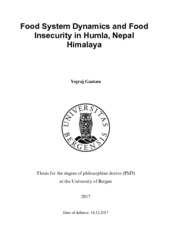| dc.contributor.author | Gautam, Yograj | |
| dc.date.accessioned | 2017-12-12T08:13:56Z | |
| dc.date.available | 2017-12-12T08:13:56Z | |
| dc.date.issued | 2017-12-14 | |
| dc.identifier.isbn | 978-82-308-3903-4 | |
| dc.identifier.uri | https://hdl.handle.net/1956/16997 | |
| dc.description.abstract | This study examines the challenges underlying food security of the Himalayan smallholder farmers focusing on three interrelated dimensions: the impact of multiple environmental and socio-economic stressors on food system, access to and role of nonfarm income sources, and the role of humanitarian and development interventions on food security and livelihoods. The results suggested that the food systems are driven by synergistic impacts of climate change and changes in forest governance through community forestry (CF) program. The CF regulated the use of forest directly affecting the livestock population. Since livestock is the sole source of soil fertility and the backbone of the traditional salt-grain trade, its population decrease has had direct impact on food production and household income. In addition, decreasing winter precipitation and increasing dry spell synergized the impacts of the CF resulting in negative food production. Adoption of off-farm income activities and utilization of food support from food assistance programs (FAPs) were the main factors that cushioned the farmers’ food deprivation to some extent. A locally disaggregated analysis revealed that there were high caste/ethnic disparities in food insecurity prevalence as well as the capacity to excel strategies to reduce it. Having too little productive land the low caste Dalits were the most food insecure group of all. Due to their little human, financial and social capital, they also failed to diversify livelihoods into high return sectors to reduce food insecurity as did their high caste counterparts. Moreover, food assistance programs being highly influenced by local politics and power failed to benefit this most food insecure group while the high caste households and those powerful in local politics reaped disproportionately higher amount of food aid. In this context, the Dalits ended up with low return activities, such as providing wage labor to the farms of high castes or serving them with their caste based skills such as smithing or tailoring in a patron-client exchange system. Since the exchange system is controlled by high caste clients, Dalits are kept in dependency, which gets intensified when environmental and socio-economic changes stress their livelihoods. Arguably, caste relation discriminated against some group and resulted into the evolution and persistence of their marginalization and food insecurity and therefore food insecurity is inherently a political problem. The insights provided by this study do not downplay the significance of critical challenges such as climate change impacts on food systems and therefore the need of agricultural production approach to enhance food system resilience. However, the focus only on technical interventions to increase production and the capacity of the production systems to adapt to change do not alter the social and political drivers that make some groups vulnerable to food insecurity. Since local social, political and economic inequities are the primary factors underlying the vulnerability of some groups, social equity should be one of the primary goals of targeted interventions so that they can ensure their ability to enhance food security through farming or through the access to profitable non-farm activities as well as from accessing humanitarian support. Conceptually, this insight corresponds to a recent call made by social scientists to invigorate social-ecological system (SES) approach by giving a stronger emphasis on social factors of system vulnerability, which the conventional SES studies largely lack. | en_US |
| dc.language.iso | eng | eng |
| dc.publisher | The University of Bergen | eng |
| dc.relation.haspart | Paper I: Gautam, Y., & Andersen, P. (2016). Rural livelihood diversification and household well-being: Insights from Humla, Nepal. Journal of Rural Studies, 44, 239-249. The article is available at: <a href="http://hdl.handle.net/1956/15660" target="blank">http://hdl.handle.net/1956/15660</a> | eng |
| dc.relation.haspart | Paper II: Gautam, Y., & Andersen, P. (2017). Multiple stressors, food system vulnerability and food insecurity in Humla, Nepal. Regional Environmental Change. 7(5), 1493-1504. Full text not available in BORA due to publisher restrictions. The article is available at: <a href="https://doi.org/10.1007/s10113-017-1110-z" target="blank">https://doi.org/10.1007/s10113-017-1110-z</a> | eng |
| dc.relation.haspart | Paper III: Gautam, Y., & Andersen, P. (2017). Aid or abyss? Food assistance programs (FAPs), food security and livelihoods in Humla, west Nepal. Food Security. 9(2), 227-238. Full text not available in BORA due to publisher restrictions. The article is available at: <a href="https://doi.org/10.1007/s12571-017-0655-5" target="blank">https://doi.org/10.1007/s12571-017-0655-5</a> | eng |
| dc.title | Food System Dynamics and Food Insecurity in Humla, Nepal Himalaya | eng |
| dc.type | Doctoral thesis | en_US |
| dc.rights.holder | Copyright the author. All rights reserved. | en_US |
| dc.identifier.cristin | 1522923 | |
